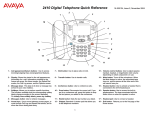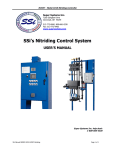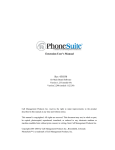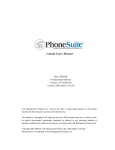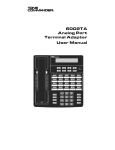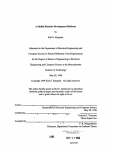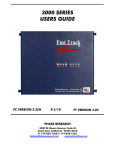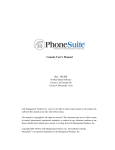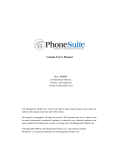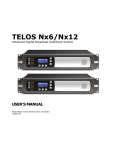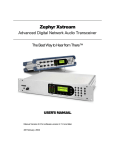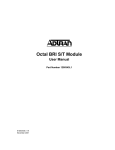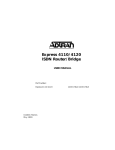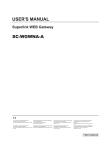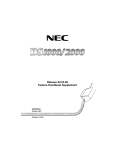Download Tone Commander 7210-7220 User Guide
Transcript
7210 / 7220
IP Centrex Telephone
User Manual
Contents
Introduction .......................................................................................... 1
General Features ............................................................................... 1
Controls and Indicators ...................................................................... 2
Operation .............................................................................................. 4
Placing a Call ..................................................................................... 4
Answering a Call ................................................................................ 6
Bridging a Shared Call Appearance................................................... 6
Displaying Call Appearance Information............................................ 7
Holding Calls ...................................................................................... 7
Transferring Calls ............................................................................... 7
Conferencing Calls ............................................................................. 8
Using Network Features..................................................................... 9
Using the Call Log ............................................................................ 10
Using the Call Directory ................................................................... 13
Using the Speakerphone.................................................................. 14
Using Voice Announce..................................................................... 15
Using a Headset............................................................................... 16
Adjusting the Receive Volume ......................................................... 16
Adjusting the Ringer Volume............................................................ 16
Installation .......................................................................................... 17
Ordering ISDN Service..................................................................... 17
7210/7220 Installation ...................................................................... 17
Wall Mounting................................................................................... 18
Configure the Set ............................................................................. 19
Customize your Phone..................................................................... 22
Label the Set .................................................................................... 23
Tone Commander 7210/7220 User Manual
i
Installation Options ........................................................................... 24
Installation Options Menu................................................................. 24
IP Addresses .................................................................................... 25
Alias Entry ........................................................................................ 27
SPID Entry........................................................................................ 28
IP Configuration and Software Updates........................................... 29
Configuring Keys .............................................................................. 33
Terminal Mode ................................................................................. 38
Voice Announce ............................................................................... 39
ISDN Parameter Download ............................................................ 42
Quality of Service ............................................................................. 43
Installation Password ....................................................................... 43
Reset to Factory Default Settings .................................................... 45
Administration Options ..................................................................... 46
Administration Options Menu ........................................................... 46
Local Inspect .................................................................................... 47
Version ............................................................................................. 50
Test .................................................................................................. 52
Diagnostic Display............................................................................ 54
Restart.............................................................................................. 55
Viewing the Error and Download Logs............................................. 56
User Options ...................................................................................... 57
User Options Menu .......................................................................... 57
Setting the Time and Date ............................................................... 58
Setting Up Speed Dial Keys............................................................. 58
Setting Up the Call Directory............................................................ 60
Personal Ringing Options ................................................................ 62
Call Preference Options ................................................................. 64
Voice Configuration.......................................................................... 65
Adjusting the Display Contrast ......................................................... 67
Setting a Call Log Password ............................................................ 68
ii
Tone Commander 7210/7220 User Manual
Troubleshooting................................................................................. 70
No Network Connection ................................................................... 70
DHCP Error ...................................................................................... 70
Network Error ................................................................................... 70
IP Lease Expiration .......................................................................... 71
Appendix A Ordering ISDN Service ............................................... 72
Recommended Button Assignments................................................ 73
Appendix B Setup Menu Tree ........................................................... 74
Appendix C Warranty and Service..................................................... 78
Appendix D Specifications ............................................................. 79
Factory Default Settings................................................................... 80
Appendix E UL/FCC Statements ....................................................... 82
Tone Commander 7210/7220 User Manual
iii
iv
Tone Commander 7210/7220 User Manual
Introduction
This document applies to telephone software version 01.02.19.
General Features ________________________
Tone Commander 7210 and 7220 IP Centrex VoIP (Voice over Internet
Protocol) Telephones are easy to use multiline terminals that provide
sophisticated ISDN services over managed IP networks. The
telephones support Centrex ISDN services provided through a
Lucent/AG Communication Systems iMerge Centrex Feature Gateway.
They include a built-in 10/100BaseT repeater to allow daisy-chain
connection of a PC workstation without additional equipment. Models
are available in white or black, with 10 (7210) or 20 (7220) call
appearances.
The optional 6030X Expansion Module adds 30 multifunction keys to
any 7210 or 7220 phone.
Model
Multifunction Keys
7210
10 (40 with 6030X)
7220
20 (50 with 6030X)
Features of the 7210 and 7220 include:
• AutoSPID and
Parameter Download
• Call Log
• Call Timer
• Last Number Redial
• Speed Dial
• Hot Key Dialing
• Direct Station Select
• Call Directory
• Flexible Ringing Options
• Ringing Control for Shared
Lines
• Automatic Switch Type
Detection
• Message Waiting Indication
• Desktop or Wall Mounting
• Tilt Display
• Integrated Speakerphone
• Voice Announce
• Handset or Headset Operation
• 10/100BaseT Repeater
• Firmware Updates via TFTP
Tone Commander 7210/7220 User Manual
1
Controls and Indicators __________________
1) Display – shows the call state, caller ID, dialed digits, network call
control messages, and elapsed time during calls. When not on a
call, the date, time of day, and softkey options are displayed.
The viewing angle can be adjusted by tilting the display, then
changing the contrast setting – see page 67.
2) Softkeys (4) – select the function displayed above the key on the
second line of the display.
3) Call Key – selects the Call Directory, Call Log, and Call
Identification Display modes.
4) Setup Key – enters Setup Mode.
5) Done Key – exits the current menu, saves any changes made, and
returns to the previous menu options.
6) More4Key – cycles through the menu option groups in Setup
Mode.
2
Tone Commander 7210/7220 User Manual
7) Message Indicator – a bright red indicator is lit when messages
are waiting; controlled by the network.
8) Multifunction Keys – select call appearances, activate network
features, or dial personal speed dial numbers. Red and green
indicators on the keys show call appearance and feature status.
Call Appearance State
Indication
Idle
OFF
Call Ringing
Green – flashing
In Use by You
Green – on steady
On Hold by You
Green – winking
In Use at Another Terminal
Red – on steady
On Hold at Another Terminal
Red – winking
9) Volume Keys – adjust the receiver/speaker volume when on a call;
adjust the ringer volume when on-hook.
10) Mute Key – mutes the microphone when using the speakerphone
or handset/headset. A red indicator on the key is lit when mute is
active.
11) Speaker Key – enables/disables the speakerphone. A green
indicator on the key is lit when the speakerphone is in use.
12) Dial Pad – dials telephone numbers, and sends DTMF tones to
external equipment such as voice mail systems. The dial pad is
used for number entry during setup.
13) Transfer Key – places the current call on hold, and selects an idle
call appearance for transferring the call. A second press completes
a transfer.
14) Conference Key – adds other parties to a conference call.
15) Drop Key – removes the last party added to a conference call, or
disconnects you from a call when not in conference mode.
16) Hold Key – places a call on hold.
17) Microphone – used for hands-free (speakerphone) calling; located
in front of the Hold key on the bottom of the telephone.
18) Handset/Headset Jack – a jack on the side of the telephone
connects to the handset or a standard headset.
Tone Commander 7210/7220 User Manual
3
Operation
Placing a Call ___________________________
Selecting a Call Appearance
If the Call Preference option (page 64) is set to Idle or Ringing, your
telephone will automatically select an idle call appearance when you go
off-hook, or activate the speakerphone when you press a Speed Dial,
DSS, REDIAL, dial pad, or UNANS-DIAL key while on-hook.
Automatic Call Appearance Selection
Lift the handset, press the Spkr key, or press a dial pad key to
select an idle call appearance.
Manual Call Appearance Selection
Press an idle (unlit) call appearance key.
Dialing
Wait for dial tone.
Dial the number with the dial pad.
The dialed number will be displayed briefly, then the network
will confirm the dialed digits in the display.
The call duration timer begins when you are connected.
Hot Key Dialing
Begin dialing by pressing a dial pad key while on-hook. An idle
call appearance, if available, will be selected automatically.
4
Tone Commander 7210/7220 User Manual
Last Number Redial
The Redial feature dials the last number that was dialed with the dial
pad or a Speed Dial key. Digits dialed after a call is connected are not
saved.
Select REDIAL to redial the last number.
Using the Call Log – refer to page 10.
Using the Call Directory – refer to page 13.
Using Speed Dial Keys
Speed Dial keys automatically dial a series of up to 24 digits when
pressed. If your telephone is on-hook, an idle call appearance will be
selected before dialing. If you are already on a call, the digits will be
dialed using DTMF tones on that call.
Use Speed Dial keys to dial frequently-called numbers, to activate
network features that include a directory number, and to speed up
dialing of access numbers for voice mail, auto attendant, and similar
systems.
Any unused multifunction key can be programmed as a Speed Dial key
– see page 37.
Press a Speed Dial key to dial a number.
The dialed digits will be shown in the display.
Using DSS Keys
DSS keys are a special type of Call Appearance/Directory Number
keys that are programmed with speed dial numbers to provide Direct
Station Selection. When the call appearance is idle or busy, DSS keys
act like Speed Dial keys, to call a station. When ringing, DSS keys act
like CA/DN keys, to answer a call.
Press an idle DSS key to dial the selected station number.
If the station associated with the DSS key is ringing, the call
appearance will be answered.
Tone Commander 7210/7220 User Manual
5
Answering a Call ________________________
When a call is ringing, the display will show the calling number (if
available) and the called number.
Lift the handset or press the Spkr key to answer the ringing
call shown in the display.
To answer a different ringing call, press the ringing Call
Appearance key before going off-hook.
Call Preference
If the Call Preference option (page 64) is set to Ringing, your telephone
will automatically answer the ringing call shown in the display when you
lift the handset or press the Spkr key.
Ringing Control
The Ringing Control option (page 63) determines how calls ring at your
telephone. Individual call appearances can be set to always ring, never
ring, or ring after a delay.
Bridging a Shared Call Appearance
________
You can bridge (connect to) an active call on a call appearance that is
shared with other terminals, unless call privacy is enabled at the
network.
Press the busy Call Appearance key for the call you want to
bridge.
Lift the handset or press the Spkr key.
The call duration timer begins when you are connected to the
call.
To disconnect from the call, replace the handset or press the
Spkr key. The other parties will remain connected.
6
Tone Commander 7210/7220 User Manual
Displaying Call Appearance Information
Call
____
Press the Call key.
Select ID (Shortcut – you can skip this step and immediately
press Call Appearance keys).
Press Call Appearance keys.
Network call information will be displayed for currently active
keys.
"NO CALL INFORMATION" and the assigned directory
number, if available, will be displayed for idle keys.
Done
Press the Call or Done key when finished.
Holding Calls ___________________________
Press the Hold key or another Call Appearance key to place
the currently connected call on hold.
The held call appearance indicator will wink with a green light.
Press the held Call Appearance key to return to the call.
Transferring Calls _______________________
Use this feature to transfer an active call to another party.
Press the Tran key while in an active call.
The current call is placed on hold, and an idle call appearance
is automatically selected. The Tran indicator flashes (on some
network switch types, the Conf indicator may light instead of
the Tran indicator).
Dial the party you want to transfer the call to with the dial pad
or a Speed Dial key.
Wait until the called party answers to announce the call, or
transfer it immediately before the called party answers.
Press the Tran key again to transfer the call.
Tone Commander 7210/7220 User Manual
7
DSS Transfer
While on an active call, press the Tran key.
Press the DSS key for the destination party.
Press the Tran key to transfer the call.
Conferencing Calls ______________________
You can initiate multi-party conference calls from your terminal.
Conferences are limited to 3 or 6 parties, depending on your network
configuration.
Conferencing a New Call
Press the Conf key while on an active call.
The current call is placed on hold and an idle call appearance
is automatically selected. The Conf indicator lights.
Dial the party you wish to add to the conference.
After the added party answers, press the Conf key to
conference all parties together.
Repeat the above steps to add another party.
Conferencing a Held Call
Press the Conf key while you are on an active call with
another call on hold.
The current call is placed on hold and an idle call appearance
is automatically selected. The Conf indicator lights.
Press the Call Appearance key for the held call you wish to
add to the conference.
Press the Conf key to conference all parties together.
Repeat the above steps to add another party.
8
Tone Commander 7210/7220 User Manual
Dropping the Last Party
Press the Drop key to remove the last party added to a
conference.
Terminating a Conference
Replace the handset or press the Spkr key to terminate a
conference, removing yourself and all other parties.
Depending on your network configuration, other parties in the
conference may remain connected or be disconnected.
Using Network Features __________________
Feature Activator keys access features provided by the telephone
network. A feature is active when the key’s red indicator is on.
Some commonly available features are listed below. Consult your
service provider for more information.
Call Forwarding
Forwards ringing calls to another number. When the Call Forward key
indicator is lit, incoming calls will be forwarded.
Privacy
Prevents other users from bridging on your active call.
Group Call Pickup
Answers a call ringing at another telephone in your workgroup.
Directed Call Pickup
Answers a call ringing at a specified telephone.
Automatic Callback (Recall)
Calls you when a dialed busy station becomes idle, then redials the
station when you answer.
Tone Commander 7210/7220 User Manual
9
Message Waiting
Lights the Message Indicator on your telephone when you have a voice
mail message.
Using the Call Log _______________________
What does the Call Log Do?
The call log maintains a running list of the last 100 incoming or
outgoing calls from your telephone. You can view the caller ID number
(if available), the date and time of the call, and elapsed time for
connected calls.
Types of Calls in the Call Log
Unanswered Incoming Calls – calls that rang at your telephone, and
were not answered. Forwarded calls are not logged.
Answered Incoming Calls – calls that were answered at your
telephone.
Outgoing Calls – calls originating from your telephone.
Viewing the Call Log
Call
Press the Call key.
DIR
CALL MENU
LOG
ID
Select LOG.
A password may be set to prevent unauthorized
entry into your call log.
When prompted for a password, enter your 4-digit
password with the dial pad. Press the Done key
after entering the password.
To change or remove the password, please refer
to page 68.
10
Tone Commander 7210/7220 User Manual
SELECT CALL LOG TYPE
UNANS ANSWD OUT
Select the type of call you want to view – UNANS
(unanswered), ANSWD (answered), or OUT (outgoing).
A key indicator will alternately flash red and green to identify
the call appearance that was used for the logged call.
To view a previous (older) call in the log, select ÅBACK.
To return to the last displayed (newer) call in the log, press the
More4 key.
To delete a call from the log, select DELETE.
9:42a 4/15 425-349-1234
DELETE DIAL TIME |BACK
To view the elapsed call time for answered calls, select TIME.
00:25:12
425-349-1234
DELETE DIAL DATE |BACK
To return to the time and date display, select DATE.
Shortcut to the Unanswered Call Log
If any calls ringing at your telephone were unanswered,
UNANS will appear in the display. You can select UNANS to
enter directly into the Unanswered call log. After you have
viewed the unanswered call log, the UNANS display indication
will clear until new calls are received.
Tone Commander 7210/7220 User Manual
11
Dialing a Call Log Entry
With the call you want to dial showing in the call log display,
select DIAL.
An idle call appearance will be automatically selected. The
directory number from the log will be shown in the second line
of the display. For outgoing calls, all digits that were dialed to
complete the original call are shown.
3=Dial:
4253491234
Add any required prefixes, then press the softkey under the
directory number to dial the digits displayed.
3=91
4253491234
12
Tone Commander 7210/7220 User Manual
Using the Call Directory __________________
What is the Call Directory?
The Call Directory is a softkey-based speed dialing system that can
store up to 36 entries. A name display identifies each entry. Use the
directory to store frequently-dialed numbers when additional Speed
Dial keys are not available.
Directory entries are displayed on nine screen pages, with four entries
per page. The current directory page number (1-9) will be shown at the
upper right of the display.
Dialing from the Call Directory
Call
Press the Call key.
DIR
CALL MENU
LOG
ID
Select DIR.
DIRECTORY
Jim G Home
More
PAGE1\
To see a different directory page, select a page by pressing a
dial pad key (1-9), or press the More4 key to cycle through
the nine pages until the desired page is displayed.
Press the softkey that is under the number you want to dial.
Call
To exit the Call Directory, press the Call key again.
To add or change directory entries, see page 60.
Tone Commander 7210/7220 User Manual
13
Using the Speakerphone
_________________
The speakerphone feature allows two-way hands-free conversation
and on-hook dialing.
Placing and Answering Calls
The Call Preference option (page 64) determines the behavior of your
telephone when the Spkr key is pressed. If this option is set to Idle or
Ringing, your telephone will automatically select an idle call
appearance when you press the Spkr key, or activate the
speakerphone when you press a Speed Dial or DSS key while onhook.
With the Ringing option selected, you can answer a ringing call
appearance by pressing the Spkr key.
Muting the Microphone
You can mute the microphone for privacy. The other party will not be
able to hear you, but you can still hear the other party.
Press the Mute key to disable or enable the microphone.
The indicator light on the Mute key will be on when the
microphone is muted.
Muting is turned off when you change from speakerphone to
handset use.
The microphone is located in front of the rubber pad on the
bottom of the telephone, in front of the Hold key.
For proper speakerphone operation, make sure that the
telephone is placed directly on a hard surface, and the
microphone is unobstructed.
14
Tone Commander 7210/7220 User Manual
Using Voice Announce ___________________
The Voice Announce feature may be used to provide hands-free call
announcing of screened calls or station-level paging when your phone
is on-hook. Incoming calls that meet specific predefined criteria (see
page 39) can be answered automatically by the speakerphone. The
microphone can be automatically disabled for announcing only, or
enabled to allow two-way conversations. You can enable or disable
Voice Announce at any time.
Enabling/Disabling
When the phone is idle, the display will show the current Voice
Announce state.
The Voice Announce state is shown only if Voice Announce
keys have been set up as explained on page 39.
Press the softkey beneath the VA display to enable or disable
Voice Announce.
UNANS VA ON
Receiving Voice Announce Calls
Calls selected for voice announcing will be answered automatically.
You and the caller will hear a double beep if your microphone is muted,
or a single beep if your microphone is enabled. The call will disconnect
when the caller hangs up. After the call has been answered, you can
pick up the handset for a private conversation, turn muting on or off,
press the Spkr key to disconnect, and perform other normal call
operations. Voice Announce is disabled when you are on an active
call with the handset, headset, or speakerphone.
CAUTION – If Call Announce is enabled for a calling directory number,
the caller should not transfer calls unscreened (blind) to your
telephone, otherwise the transferred call will be answered using Voice
Announce.
Tone Commander 7210/7220 User Manual
15
Using a Headset
________________________
Headset Mode Operation
Your telephone can be set for handset or headset use (see page 65).
With a headset, the Spkr key is used as the hookswitch, and the
speakerphone feature is disabled.
Optimizing the Phone to Match Your Headset
Headset models may vary in their microphone sensitivities and receive
levels. Your telephone provides adjustments for transmit and receive
levels to accommodate most headsets – see page 65.
Adjusting the Receive Volume _____________
The Vol5 and Vol6 keys adjust the receive volume level for the
handset, headset, and speakerphone while you are on a call.
The telephone stores individual preset volume settings for the handset
and headset. Volume settings return to the programmed preset levels
after a call is completed. See page 65 to change the preset values.
Changes to speakerphone volume levels are retained after a call is
completed.
Adjusting the Ringer Volume ______________
The Vol5 and Vol6 keys adjust the ringer volume while you are not
on a call.
The telephone will ring once with the new ringer volume setting, and
the new setting will be shown briefly in the display.
When the volume is at the lowest setting, the phone will display
"RINGER OFF" instead of the date and time when idle. Press the Vol5
key while you are not on a call to enable the ringer.
RINGER OFF
REDIAL
16
Tone Commander 7210/7220 User Manual
Installation
Ordering ISDN Service ___________________
ISDN ordering forms may be supplied by your service provider. You
can also print forms using the PC-based Configuration Wizard. Please
refer to Appendix A in this manual.
Consult your service provider to plan your service installation. Allow
adequate time after cutover for testing of all call appearances and
programmed features. Ask your service provider for your alias and
H.235 password, and confirm the installation date.
7210/7220 Installation ____________________
Network Connection
Connect the NET jack on the phone to the LAN switch using a
Category 5 or better cable. Route the cable under the guide tabs in the
phone base.
PC Connection
If you want to use a PC on the same network connection, connect the
PC network interface card to the phone's PC jack switch using a
Category 5 or better cable. Route the cable under the guide tabs in the
phone base.
The PC port device's speed must match that of the device connected to
NET port (LAN switch or hub). If the NET port is connected to a
100Mbps device (either dual or single speed), a 10Mbps device
connected to the PC port will not work properly. If the NET port is
connected to a 10Mbps device, a 10Mbps device (or 10/100Mbps dualspeed device) connected to the PC port will communicate properly at
10Mbps.
Handset/Headset
Plug the supplied handset or a compatible headset into the jack on the
left side of the telephone.
Tone Commander 7210/7220 User Manual
17
Power
Power must be provided by the Tone Commander 901034 power
supply. Connect power after all other connections are complete. The
7210 and 7220 are not compatible with IEEE LAN-based power.
Plug the power supply barrel connector into the round jack on the
bottom of the phone (under the speaker). Connect the power supply to
a standard 120 VAC, 60 Hz grounded power outlet.
Wall Mounting __________________________
Robust handset retainer clips for wall mount use are available on
request from Tone Commander.
Rotating the Base
The phone base must be rotated for wall mounting.
• Disconnect power, PC, and network cables.
• Remove the retaining screw in the center of the base.
• Press the top of the tall edge of the base to disengage the snap
tabs, then lift the base from the telephone body.
Make sure the cable from the base remains fully seated in the
connector on the phone.
• Turn the base 180°, insert the tabs on the short edge of the base
into the holes near the display end of the telephone, and then snap
the tall side of the base onto the telephone.
• Replace the retaining screw (required for UL compliance).
Attaching to a wall mount jack
• Plug an 8”, 10/100BaseT network cable into the NET jack on the
telephone. Route the cord under the guide tabs on the base.
• Hold the telephone next to the wall mount jack. Plug the network
cable into the jack.
• Hang the telephone on the wall plate mounting studs. Press down
firmly to lock in place.
• Push any excess network cable into the base.
18
Tone Commander 7210/7220 User Manual
Configure the Set
_______________________
ISDN configuration is performed automatically in many cases. The
telephone set will detect the switch type, set the SPID number, and
download other setup parameters when these features are available
from the central office.
You will be prompted for any required setup information that cannot be
set automatically.
Initialization
A self-test is performed upon power up, followed by terminal
initialization. Initialization begins after a short random time interval. This
delay prevents multiple terminals at a site from initializing
simultaneously after a power outage.
The display will show progress while establishing the communication
layers. When all communication layers are established, the IP
connection speed and switch type will be shown for several seconds.
PHY:100MBPS IP:LINKED
L3:OK
SWITCH=5ESS NI-X
IP addresses are normally assigned via DHCP server. In the case
where there is no DHCP server or no server response, the following
display will be shown:
DHCP ERROR, RETRYING
PRESS SETUP TO CONFIGURE
If the IP address, default gateway, or subnet mask have changed, the
following will be shown:
RESTART WITH NEW VALUES?
YES
Select YES to restart the phone using the new addresses or subnet
mask.
Tone Commander 7210/7220 User Manual
19
Alias
If the alias is rejected by iMerge or there is no stored alias, the
following will be shown:
ALIAS=
|BKSP
CLEAR
Enter the correct alias as supplied by your service provider,
then press the Done key.
Done
H.235 Password
If H.235 password is rejected by iMerge or there is no stored password,
the following will automatically be shown:
H235 PW=
|BKSP
Done
CLEAR
Enter the correct password as supplied by your service
provider, then press the Done key. If passwords are not used,
press the Done key with no entry.
To change the existing H.235 password and iMerge alias after
the phone is registered, select CHANGE from the Alias entry
menu (Setup → INSTL → ALIAS → CHANGE).
When the phone's initialization is complete, a time and date
display will be shown.
JAN 10, 2002
12:42 PM
SPID Entry
The SPID number may be assigned automatically if the network
supports National ISDN AutoSPID, or a generic format SPID is used.
If AutoSPID is not supported, the phone will attempt to “guess” the
correct SPID based on the alias. If the network does not accept this
“guessed” SPID, you will be prompted to enter the phone’s primary
telephone number, which is used by the phone to generate a SPID
20
Tone Commander 7210/7220 User Manual
number. Enter the number with the dial pad, then press the Done key.
BKSP (backspace) deletes the previous digit.
National ISDN
– enter your full 10-digit telephone number
(including area code)
5ESS Custom ISDN – enter your 7-digit telephone number
ENTER PRIMARY PHONE #
785-1243
|BKSP
Parameter Download (National ISDN only)
Parameter Download is a network feature that identifies Call
Appearance and Feature Activator keys that are assigned to your line
so that your phone may be configured automatically.
Note: Speed Dial and DSS keys are not configured by Parameter
Download, as well as other features listed on page 22
(Customize your Phone).
If Parameter Download is not supported, the following screen may
appear momentarily, prompting you to manually configure the
telephone at a later time (see page 24).
NO PARAMETER DOWNLOAD
PRESS SETUP TO CONFIGURE
Automatic Button Detection (5ESS Custom ISDN only)
Press each multifunction key. The phone will discover the key's
network assignment. Keys that have no network assignment may be
used for speed dialing – please refer to page 37.
Firmware Updates
Call Tone Commander Engineering at (800) 524-0024 to get
information on firmware updates.
Tone Commander 7210/7220 User Manual
21
Using Local Inspect to Verify Keys
Local Inspect allows you to identify the call appearance or feature
assignment of each configured key, directory number bearer
capabilities, and the feature indicator assignment for the Message
Indicator. Please refer to page 47.
Customize your Phone ___________________
You can set the following options on your phone.
DSS – converts Call Appearance keys to Direct Station Selection keys
with busy lamp indication for one-button speed dialing of stations that
are monitored by your phone (page 36).
Clock – sets the time-of-day clock. The clock is used for the time and
date display, and for time stamping calls in the call log (page 58).
Speed Dial – sets up spare keys for one-button speed dialing of
frequently-called numbers (page 58).
Feature Activators with Speed Dial – sets up spare keys for onebutton dialing of features such as Call Forward or Directed Call Pickup,
with a preselected destination (page 37).
Call Directory – sets up the display-based speed dialing directory
(page 60).
Personal Ringing
Ringing Tone – selects a distinct ringing tone for your telephone,
to distinguish it from other nearby ringing telephones (page 62).
Off-hook Ringing – selects single burst or normal ringing when
you are on a call (page 62).
Ringing Control – controls audible ringing for individual call
appearances (page 63).
Call Preference – controls automatic call appearance selection and
automatic call answering when you go off-hook (page 64).
22
Tone Commander 7210/7220 User Manual
Voice Mode
Handset/Headset Mode – selects handset or headset operation
(page 65).
Preset Volume Levels – sets handset and headset volume levels,
and speakerphone transmit level (page 65).
Display Contrast – adjusts the contrast of the display for best visibility
(page 67).
Call Log Password – sets or removes a password to control entry into
the call log (page 68).
Voice Announce – enables or disables automatic call answering by
the speakerphone (page 39).
Label the Set ___________________________
Label the multifunction keys with the telephone number, feature name,
speed dial party name, or other appropriate designation. A perforated
label sheet is provided with the telephone.
An ISDN Telephone Setup Wizard for Windows 95/98/NT/XP can be
downloaded from Tone Commander’s web site. This program prints
key labels and service ordering forms. A Microsoft Word template for
key labels only is also available. Please refer to Appendix A on page
72.
If you want to manually create labels, use paper strips 5” wide x ¼”
high. Label text is on 1” centers, with 0.9” text space for each key.
To install the labels, remove the plastic overlay surrounding the
multifunction keys. Peel off the protective strips from the adhesive in
the grooves beneath the keys. Insert the label strips in the grooves,
then replace the overlay.
Tone Commander 7210/7220 User Manual
23
Installation Options
Options in this section are typically set at the time of installation. Many
options can be set automatically by the DHCP, TFTP, AutoSPID,
Automatic Switch Detect, and Parameter Download features, if
supported on the network.
The following options can be changed from the Installation Options
menu:
•
•
•
•
•
•
IP Addresses
Alias
SPID
Configuration Updates
Key Configuration
Terminal Mode
•
•
•
•
•
Installation Options Menu
Voice Announce
Parameter Download
Quality of Service
Installation Password
Reset to Default Settings
________________
You can enter the Installation Options menu when the phone is idle.
Setup
Press the Setup key.
SETUP MENU
INSTL ADMIN USER
Select INSTL.
INSTALLATION OPTIONS
\
IP ALIAS SPID UPDATE
More
When Æ appears in the top line of the display, you can press
the More4 key to see additional menu selections.
INSTALLATION OPTIONS
\
KEYS MODE
VA
PARAM
INSTALLATION OPTIONS
QoS PASSWD RESET
\
Note: The MODE option is only available with National ISDN.
24
Tone Commander 7210/7220 User Manual
A password may be set to prevent unauthorized
entry into the Installation Options menu.
When prompted for a password, enter your 4-digit
password with the dial pad. Press the Done key
after entering the password.
To change or remove the password, please refer to
page 43.
IP Addresses ___________________________
IP address entries are required for the phone, subnet mask,
gateway/router, iMerge, and optional TFTP and SNTP servers. The
default setting uses DHCP to automatically set the phone address,
subnet mask, TFTP server address, SNTP server address, time offset,
and gateway/router address. The phone can obtain the iMerge
address, as well as software updates, and QoS settings from a TFTP
server. Please refer to the 7210/7220 Network Administration Guide.
Note: you must restart the phone after any IP address changes have
been made for the changes to take effect
(Setup → ADMIN → More4 → RESTART).
Disabling IP Configuration via DHCP (not recommended)
From the Installation Options menu, select UPDATE.
(Setup → INSTL → UPDATE)
IP CONFIGURATION UPDATE
DHCP TFTP FLASH TELNET
Select DHCP.
DHCP=ENABLED
ENABLE DISABLE
Tone Commander 7210/7220 User Manual
25
If DHCP is currently enabled, select DISABLE.
DHCP=DISABLED
ENABLE DISABLE
Done
Press the Done key to return to the IP Configuration Update
menu or the Setup key to exit Setup Mode.
Manual IP Configuration
DHCP should be disabled if manual IP configuration is used; IP
addresses configured via DHCP will overwrite manually entered values.
From the Installation Options menu, select IP.
(Setup → INSTL → IP)
IP ADDRESSES
\
PHONE GATEWY TFTP iMERGE
IP ADDRESSES
SNTP SUBNET
\
Select PHONE, TFTP, GATEWY, iMERGE, SNTP, or
SUBNET.
Using the dial pad, enter the IP addresses. Address format is
four groups of 1-3 digits. You must enter leading zeroes for
each group of digits. Periods are automatically displayed.
If you need to make corrections, select ÅBKSP (backspace)
to delete the previous digit.
CLEAR removes all digits, allowing you to start over.
PHONE=192.169.073.104
|BKSP CLEAR PING
The subnet mask is entered in a similar manner; the default
value of 255.255.255.0 will suffice in most cases.
For SNTP, select OFFSET to specify the time offset (in hours)
from UTC for your local time zone.
26
Tone Commander 7210/7220 User Manual
To test the phone, gateway/router, TFTP server, SNTP server,
or iMERGE address, select PING. If you have entered a new
phone IP address, the phone must be restarted before ping
will work properly.
PINGING IP ADDRESS...
If a response is received, indicating a valid address, "PING
SUCCESSFUL" will be displayed.
PING SUCCESSFUL
PRESS ANY KEY
If no response is received, the entered address is invalid.
"PING FAILED" will be displayed.
PING FAILED
PRESS ANY KEY
Press any key to return to the previous menu.
Alias Entry _____________________________
A unique iMerge alias is required for operation of the 7210/7220.
Contact your network service provider for your telephone’s alias.
From the Installation Options menu, select ALIAS.
(Setup → INSTL → ALIAS)
ALIAS=3094770185
|BKSP
CLEAR
If the phone is currently registered with an iMerge alias, select
CHANGE, then YES to restart the phone and clear the
existing alias. The existing SPID and H.235 password will also
be cleared.
Tone Commander 7210/7220 User Manual
27
Using the dial pad, enter the alias supplied by your network
service provider.
If you need to make corrections, select ÅBKSP (backspace)
to delete the previous digit.
CLEAR removes all digits, allowing you to start over.
Done
When all digits have been entered, press the Done key to
return to the Change Password menu or the Setup key to exit
Setup Mode.
SPID Entry _____________________________
A unique SPID (Service Profile IDentifier) is required for operation of
the 7210/7220. If the network supports AutoSPID, a SPID that is
assigned to your ISDN line can be automatically selected. If generic
SPID assignments are used by your service provider, your SPID will
consist of your primary telephone number followed by “0101” for
National ISDN (e.g., 52534910000101). Contact your network service
provider for your telephone’s SPID.
The alias value, if correctly entered, will be copied to the SPID entry.
You can edit this SPID entry if necessary.
From the Installation Options menu, select SPID.
(Setup → INSTL → SPID)
ID=42534910000101
|BKSP CLEAR
Using the dial pad, enter the SPID number supplied by your
network service provider.
If you need to make corrections, select ÅBKSP (backspace)
to delete the previous digit.
CLEAR removes all digits, allowing you to start over.
Done
When all digits have been entered, press the Done key to
return to the Installation Options menu or the Setup key to exit
Setup Mode.
If the phone is currently initialized with a SPID, select
CHANGE, then YES to restart the phone and clear the
existing SPID. The iMerge alias and H.235 password will also
be cleared.
28
Tone Commander 7210/7220 User Manual
IP Configuration and Software Updates _____
Telephone operating software and configuration parameters can be
automatically updated daily from the TFTP server at a preset time,
manually updated from the phone using files on the TFTP server, or
updated from a client PC.
Automatic Update
A properly configured network TFTP server is required for automatic
updates. Please refer to the 7210/7220 Network Administration Guide.
From the Installation Options menu, select UPDATE.
(Setup → INSTL → UPDATE)
IP CONFIGURATION UPDATE
DHCP TFTP FLASH TELNET
Select TFTP.
TFTP CONFIG UPDATE
START AUTO
Select AUTO.
TFTP UPDATE=DISABLED
ENABLE
If TFTP updates are currently disabled, select ENABLE.
TFTP UPDATE TIME=03:26AM
DISABLE
|BKSP AM/PM
Enter new digits for the update time with the dial pad. The
cursor will advance automatically as each digit is entered.
Time must be entered in 12-hour format. AM/PM is changed
with a softkey.
The minutes value is calculated based on the MAC address of
the phone, to minimize the possibility of multiple phones
Tone Commander 7210/7220 User Manual
29
simultaneously requesting updates. You may manually enter
the minutes digits, but it is recommended that you use the
default calculated value.
If you need to make corrections, select ÅBKSP (backspace)
to delete the previous character.
Done
When all changes have been made, press the Done key to
return to the IP Configuration Update menu or the Setup key
to exit Setup Mode.
Manual Update
To perform a manual update, the phone must have the TFTP server’s
IP address entered manually or downloaded via DHCP.
From the Installation Options menu, select UPDATE.
(Setup → INSTL → UPDATE)
IP CONFIGURATION UPDATE
DHCP TFTP FLASH TELNET
Select TFTP.
TFTP CONFIG UPDATE
START AUTO
Select START to initiate the manual update.
READING CONFIGURATION
FROM TFTP SERVER...
"Restarting" indicates that new operating software is being
loaded into the phone. When complete, the phone will restart.
RESTARTING FOR NEW
SOFTWARE DOWNLOAD...
30
Tone Commander 7210/7220 User Manual
If a new version program is not found, the following screen will
be shown. Press any key to return to the previous menu.
TFTP VERS SAME AS PHONE
PRESS ANY KEY
If phone configuration files are missing from the TFTP server,
or the correct TFTP server address has not been entered or
set via DHCP, the following screen will be shown.
NO TFTP SERVER RESPONSE
EDIT
Select EDIT.
TFTP=216.122.043.234
|BKSP CLEAR PING
Enter the correct TFTP server address. You can verify the
address by selecting PING. When finished, press the Done
key.
If you need to make corrections, select ÅBKSP (backspace)
to delete the previous digit.
CLEAR removes all digits, allowing you to start over.
Update from a Client PC
Telephone software can also be updated from a network client PC
running Tone Commander's Flash Update program.
To enable flash updates:
From the Installation Options menu, select IP.
(Setup → INSTL → UPDATE)
IP CONFIGURATION UPDATE
DHCP TFTP FLASH TELNET
Tone Commander 7210/7220 User Manual
31
Select FLASH.
FLASH UPDATE=DISABLED
ENABLE DISABLE
Select ENABLE.
FLASH UPDATE=ENABLED
ENABLE DISABLE
After updating, you can disable flash updates to prevent inadvertent
changes to the phone configuration.
Telnet
This option allows a telnet client to connect to the phone for
troubleshooting purposes.
From the Installation Options menu, select UPDATE.
(Setup → INSTL → UPDATE)
IP CONFIGURATION UPDATE
DHCP TFTP FLASH TELNET
Select TELNET.
TELNET ACCESS=DISABLED
ENABLE DISABLE
Select ENABLE.
TELNET ACCESS=ENABLED
ENABLE DISABLE
When telnet capability is no longer needed, disable it to prevent
inadvertent changes to the phone configuration.
32
Tone Commander 7210/7220 User Manual
Configuring Keys
_______________________
If the network does not support ISDN Parameter Download, you must
assign call appearances, directory numbers and feature activators
using this option.
From the Installation Options menu, select KEYS.
(Setup → INSTL → KEYS)
The status indicator for each key will indicate the current
setting.
Green – Call Appearance or DSS.
Red
– Feature Activator.
Off
– Unused or Speed Dial.
On the phone or expansion module, press the multifunction
key to be programmed.
The selected key’s indicator will alternately flash red and
green.
12=CA/DN
CA/DN
FA
12=CA/DN
UNUSED
DSS
\
SPDIAL
\
Select CA/DN (Call Appearance /Directory Number), FA
(Feature Activator), DSS (Direct Station Select), SPDIAL
(Speed Dial), or UNUSED from the menu.
12=CA/DN# 555-789-4251
|BKSP
ORIG RESERV
Programming procedures for each key type are described
below.
Tone Commander 7210/7220 User Manual
33
Call Appearance / Directory Number Keys
These “line” keys are used to place and answer calls. If you have
BASIC service, each directory number key is assigned a unique
directory number. If you have CACH EKTS service, one directory
number may be assigned to multiple Call Appearance keys; multiple
calls can be handled on one directory number.
Enter the assigned directory number with the dial pad.
If you need to make corrections while entering numbers,
select ÅBKSP (backspace) to delete the previous digit.
You can press the Done key to return to key selection.
12=CA/DN# 555-789-4251
|BKSP
ORIG RESERV
Automatic Call Appearance Selection
A call appearance is automatically selected when originating a new
call, answering an incoming call, or conferencing or transferring a call.
Three configuration options determine how call appearances are
selected:
Call Preference (page 64) – determines whether a new call is
originated when you lift the handset or press the Spkr key. If set to
NONE, you must manually press a Call Appearance key to originate
a call.
Originating DN – only call appearances with this option set to YES
will be automatically selected for call origination.
CA Reservation – within the group of originating DNs, call
appearances set for NOT RESERVED are selected first, followed by
OUTGOING ONLY, followed by OUT/PRIORITY call appearances
(OUTGOING ONLY call appearances are selected first for
conferencing and transferring). Within each subgroup, call
appearances are selected in ascending order. INCOMING ONLY
call appearances are never selected for an outgoing call. If an idle
CA is not found, “SELECT AN IDLE LINE” is displayed.
34
Tone Commander 7210/7220 User Manual
To change the Originating DN assignment:
Select ORIG.
Select YES or NO from the Originating DN menu.
Done
Press the Done key to return to the CA/DN menu.
To change call appearance reservation:
Select RESERV.
Select the call appearance reservation for this CA/DN.
OUT – Originate (outgoing calls) only.
IN
– Terminate (incoming calls) only.
PRI – Outgoing or priority incoming or calls only.
NOT – Not Reserved – default value for all keys.
Done
Press the Done key to return to the CA/DN menu.
Feature Activator Keys
Feature Activator keys must be configured to match network feature
activator codes that have been assigned to your line.
Using the dial pad, enter the feature activator code assigned
by your network service provider.
If you need to make corrections while entering numbers,
select ÅBKSP (backspace) to delete the previous digit.
10=NETWORK FA#59
|BKSP
(CALL)
CALL
Select CALL if a call needs to be originated when the feature
is activated. When enabled, (CALL) will appear in the top line
of the display as shown above.
With CALL enabled, the feature is always activated within the
context of a call. Features that need to originate a call include
Call Forward (on Siemens EWSD), ICM intercom (on Nortel
DMS-100), and Call Pickup. The CALL feature is not used
with Lucent 5ESS Custom ISDN.
Tone Commander 7210/7220 User Manual
35
If the phone is on-hook when a Feature Activator key with
CALL enabled is pressed, a new call will be originated. If the
phone is already off-hook when the feature key is pressed, the
feature will be activated within the context of the current call.
Done
Press the Done key twice to return to the key selection menu
or the Setup key to exit Setup Mode.
DSS Keys
DSS keys are a special type of Call Appearance/Directory Number
keys that are programmed with speed dial numbers to provide Direct
Station Selection. When the call appearance is idle or busy, DSS keys
act like Speed Dial keys, to call a station. When ringing, DSS keys act
like CA/DN keys, to answer a call. The LED indicator on the key shows
the status of the station’s call appearance (idle, ringing, hold, busy).
Shared call appearances for stations you wish to monitor must be
configured on your ISDN line. You must program the DSS number to
dial the monitored station on your phone (even if Parameter Download
is provided).
If the Call Appearance/Directory Number is not shown in the
top line of the display, you can enter a reference directory
number for the monitored station with the dial pad. This
number is not required for operation.
If you need to make corrections while entering numbers,
select ÅBKSP (backspace) to delete the previous digit.
08=DSS/DN# 425-349-1001
|BKSP DSS#
Select DSS#.
1001
|BKSP CLEAR
PAUSE
Using the dial pad, enter the number you would dial to call the
monitored station.
If you need to make corrections while entering numbers,
select ÅBKSP (backspace) to delete the previous digit.
CLEAR removes all digits, allowing you to start over.
36
Tone Commander 7210/7220 User Manual
Done
Press the Done key three times to return to the key selection
menu or the Setup key to exit Setup Mode.
Speed Dial Keys
Keys not assigned for call appearances or feature activators may be
used as Speed Dial keys. Dial strings can include network feature
activator codes, to simplify the use of features such as Directed Call
Pickup and Call Forwarding. Speed Dial keys may also be programmed
from the User Options menu.
5553452341
|BKSP CLEAR
PAUSE
FA
The currently programmed dial string, if any, will be shown in
the display.
Enter digits (24 maximum) with the dial pad.
Pauses are entered with the PAUSE softkey, and are shown
in the display as a P character. The first pause in a dial string
will wait until the call is answered; additional pauses delay
dialing for one second. Enter multiple pauses to increase the
delay time.
|BKSP
PAUSE
FA
5551234P1P12
|BKSP CLEAR PAUSE
Feature Activator (FA) numbers are entered with the FA
softkey, and are shown in the display as an F character. It
must be the first character in the dialing string; the two
numeric digits immediately following the F indicate the
network feature activator code. The FA softkey is only
available when no digits have been entered. In the example
above, the Speed Dial key sends feature code ‘57’ (Call
Forward) followed by the directory number ‘987-1234’.
Tone Commander 7210/7220 User Manual
37
If you need to make corrections while entering numbers,
select ÅBKSP (backspace) to delete the previous digit.
CLEAR removes all digits, allowing you to start over. A Speed
Dial key will revert to 'Unused' if saved with a cleared dial
string.
F579871234
|BKSP CLEAR PAUSE
Done
When digits have been entered, press the Done key twice to
return to the key selection menu or the Setup key to exit
Setup Mode.
Terminal Mode __________________________
(National ISDN only)
If the network does not support Parameter Download, you must
manually select the terminal mode.
From the Installation Options menu, select MODE.
(Setup → INSTL → More4 → MODE)
TERMINAL MODE=CACH EKTS
CACH BASIC
Select the terminal mode based upon the type of service that
was ordered from your network service provider.
CACH – CACH EKTS.
BASIC – Voice or Basic EKTS.
In most cases, your phone service should be configured for
CACH EKTS.
Done
38
Press the Done key to return to the Installation Options menu
or the Setup key to exit Setup Mode.
Tone Commander 7210/7220 User Manual
Voice Announce
________________________
This option allows certain incoming calls to be answered automatically
by the speakerphone. Voice Announce calls are restricted to calls on
selected Call Appearance/Directory Number keys. In addition, calls
from specified directory numbers, and/or calls of a selected type
determined by the ringing pattern, can be restricted. The microphone
can be automatically disabled for announcing only, or enabled to allow
two-way conversations. Voice Announce can be enabled or disabled by
the user at any time.
From the Installation Options menu, select VA.
(Setup → INSTL → More4 → VA)
VOICE ANNOUNCE OPTIONS
KEYS DNs ALERT MUTE
Selecting CA/DN Keys
Select KEYS to designate individual call appearances that will
accept Voice Announce calls. Use this setting to restrict Voice
Announce calls to specific dialed directory numbers (e.g. nonlisted private numbers).
SELECT VA KEYS
GREEN=VA, RED=AVAILABLE
All available CA/DN keys will light red, Voice Announce
enabled keys will light green; all other keys will be off. Press
desired call appearance keys to enable or disable the Voice
Announce feature for selected keys.
Set all appearances of a directory number to the same
Voice Announce setting.
Done
Press the Done key when all Voice Announce keys have been
selected.
Tone Commander 7210/7220 User Manual
39
Voice Announce configuration is not affected by Parameter Download,
except when CA/DN key allocations change. The default Voice
Announce setting for new CA/DN keys identified in a download is
disabled.
Selecting Incoming Directory Numbers
CA/DN keys must be configured for Voice Announce before selecting
incoming DNs.
Select DNs to restrict Voice Announce calls to specific callers
(or groups of callers). The Calling DN templates are matched
to the incoming caller ID to identify Voice Announce calls. You
can enter up to three Calling DN templates.
CALLING DN#1=4253491*
|BKSP CLEAR ALL
Select ALL if you want to accept all incoming calls.
To restrict Voice Announce calls to specific callers or groups,
use CLEAR or ÅBKSP to delete the current entry, then enter
a combination of wild cards (* matches any group of
characters, # matches a single character) and numeric digits
with the dial pad to allow individual callers or blocks of callers.
For example, 4253491* matches 425-349-1000 through
425-349-1999; 42534910#0 matches 425-349-1010,
425-349-1020, etc. Non-numeric characters (such as
hyphens) in the incoming caller ID are ignored. Up to 10 digits
(including wild cards) may be programmed in each template.
Enter all digit positions as shown in the display for an
incoming call; in most cases, this will include the area
code.
More
Done
40
Press the More4 key to enter additional Calling DN
templates.
When all Calling DN templates have been entered, press the
Done key.
Tone Commander 7210/7220 User Manual
Selecting Alerting Patterns
Use the Alert option to allow only specific types of incoming calls (e.g.
internal, external, intercom, etc.).
CA/DN keys must be configured for Voice Announce before selecting
alerting patterns.
Select ALERT to define a specific alerting pattern required to
validate incoming Voice Announce calls.
ALERTING=ANY
\
ANY NORMAL DIST INTCOM
ALERTING=ANY
PRI
ANY
\
– Accept any type of alerting (default value)
NORMAL – normal alerting (pattern 0); typically used for
internal calls.
DIST
– distinctive alerting-intergroup (pattern 1); typically
used for external calls
INTCOM – EKTS intercom (pattern 3); used for intercom
calls
PRI
Done
– distinctive alerting-special/priority (pattern 2);
used for designated priority calls
Press the Done key after selecting the alerting pattern.
Automatic Muting
Select MUTE.
AUTOMATIC MUTE=ON
ON
OFF
Tone Commander 7210/7220 User Manual
41
Select ON to automatically mute the microphone during a
Voice Announce call, or OFF to enable two-way
conversations.
Done
Press the Done key after selecting the muting option.
ISDN Parameter Download ________________
(National ISDN only)
ISDN Parameter Download is an automated feature for configuring Call
Appearance and Feature Activator keys. If configured for auto
download, a Parameter Download is executed when the phone
initializes with a new SPID, or when requested by the network, due to a
line configuration change.
Note: Speed Dial and DSS keys are not configured by Parameter
Download.
From the Installation Options menu, select PARAM.
(Setup → INSTL → More4 → PARAM)
ISDN PARAMETER DOWNLOAD
START AUTO
Starting a Download
Select START to manually initiate a Parameter Download.
Enabling/Disabling Automatic Download
Select AUTO.
AUTO DOWNLOAD=ENABLED
ENABLE DISABLE
Select ENABLE or DISABLE.
42
Tone Commander 7210/7220 User Manual
Quality of Service _______________________
Quality of Service settings should not be changed unless required by
your network administrator to optimize IP network performance. Please
refer to the 7210/7220 Network Administration Guide.
Installation Password ____________________
You can set a password to prohibit unauthorized entry into the
Installation Options menu.
If a password is currently set, the display will prompt you to enter your
password prior to making changes.
From the Installation Options menu, select PASSWD.
(Setup → INSTL → More4 → More4 → PASSWD)
INSTALLATION PASSWORD
SET CLEAR
Select SET.
NEW PASSWORD:---|BKSP
Enter a new 4-digit password with the dial pad.
If you need to change a password digit after entering it, select
ÅBKSP (backspace) to delete the previous digit.
Done
Press the Done key.
VERIFY PASSWORD:---|BKSP
Repeat the password when prompted to verify the new entry.
Done
Press the Done key.
“PASSWORD SET” will be displayed to confirm the new
password.
Tone Commander 7210/7220 User Manual
43
PASSWORD SET
Record your password for future reference.
Done
Press the Done key to return to the Installation Options menu
or the Setup key to exit Setup Mode.
Removing the Password
Select CLEAR.
“PASSWORD CLEARED” will be displayed to confirm that the
password has been removed.
PASSWORD CLEARED
Done
Press the Done key to return to Change Password menu or
the Setup key to exit Setup Mode.
What to do if you lose your password
Contact your system administrator or call Tone Commander technical
support at (800) 524-0024 in the event you misplace your password.
You will need to report the serial number of your telephone to receive a
new password.
You can use the RESET option described below to remove all
passwords. This option will clear all programmed numbers and settings
in your phone.
44
Tone Commander 7210/7220 User Manual
Reset to Factory Default Settings __________
Reset returns all settings to the factory defaults, and clears the SPID,
alias, all speed dial numbers, logs, and passwords. This option is
useful when moving the telephone to a new user or location.
Default values are listed in the table on page 80.
From the Installation Options menu, select RESET.
(Setup → INSTL → More4 → RESET)
RESET ALL SETUP OPTIONS?
YES
NO
Select YES to confirm the reset operation.
ALL SETTINGS CLEARED
Done
Press the Done key to return to Installation Options menu or
the Setup key to exit Setup Mode. The phone will restart.
Tone Commander 7210/7220 User Manual
45
Administration Options
The following test and diagnostic options are available from the
Administration Options menu:
•
•
•
•
•
Local Inspect
Hardware Version
Software Version
Serial Number
MAC Address
•
•
•
•
Test Functions
Diagnostics
Terminal Restart
Error Log
Administration Options Menu
_____________
You can enter from the Administration Options menu when the phone
is idle or during an active call.
Setup
Press the Setup key.
SETUP MENU
INSTL ADMIN USER
Select ADMIN.
ADMINISTRATION OPTIONS \
INSPCT VERS TEST DIAG
More
When Æ appears in the top line of the display, you can press
the More4 key to see additional menu selections.
ADMINISTRATION OPTIONS \
RESTART LOG
46
Tone Commander 7210/7220 User Manual
Local Inspect ___________________________
Local Inspect allows you to identify the call appearance/directory
number or feature assignment of each configured key, directory
numbers, and the feature indicator assignment for the Message
Indicator. You can use Local Inspect after a Parameter Download to
verify call appearance and feature assignments.
From the Administration Options menu, select INSPCT.
(Setup → ADMIN → INSPCT)
LOCAL INSPECT
KEYS
DNs
MESSAGE
Select KEYS, DNs (Directory Numbers), or MESSAGE
(Message Indicator). Each option is described below.
Keys
Select KEYS.
Press the key that you want to inspect.
The key’s indicator will alternately flash red and green.
Displays will vary depending upon the key type, as shown
below.
Done
When you are finished inspecting keys, press the Done key to
return to the Local Inspect menu or the Setup key to exit
Setup Mode.
Call Appearance/Directory Number Key
The display will show for the selected key:
• Key number, directory number
01=CA/DN# 555-349-1012 \
Tone Commander 7210/7220 User Manual
47
More
Press the More4 key to view:
• Originate usage
• Call appearance reservation
ORIGINATING DN? YES
\
RESERVED=OUT/PRIORITY IN
DSS Key
The display will show for the selected key:
• Key number, directory number
• DSS number
05=DSS/DN# 555-789-4251\
4251
More
Press the More4 key to view:
• Originate usage
• Call appearance reservation
ORIGINATING DN? NO
RESERVED=NOT RESERVED
\
Feature Activator, Conference, Transfer, or Drop Key
The display will show the key number, network feature
activator number, and service description for the selected key.
07=NETWORK FA#56
Call Pickup
(CALL)
(CALL) is displayed if the feature has been locally
programmed to originate a call when activated (see page 35).
48
Tone Commander 7210/7220 User Manual
Speed Dial Key
The display will show the key number and programmed
autodial string for the selected key.
08=SPEED DIAL
5553452341
Directory Numbers
Select DNs to view the list of directory numbers on this phone.
The first line on the display will show the directory number,
and ‘ORIG’ if this is an originating DN.
DN#555-345-8952
More
Done
ORIG \
Press the More4 key to view additional directory numbers.
Press the Done key to return to the Local Inspect menu or the
Setup key to exit Setup Mode.
Message Waiting Indicator
Select MESSAGE.
The Message indicator will light.
The display will show the feature indicator number and the
service description, if available. If the service description on
line 2 is blank after a Parameter Download, this feature has
not been provisioned on your line.
MESSAGE=NETWORK FI#63
Message Waiting
Done
Press the Done key to return to the Local Inspect menu or the
Setup key to exit Setup Mode.
Tone Commander 7210/7220 User Manual
49
Version ________________________________
Use this option to view the telephone’s hardware version, software
version, and serial number.
From the Administration Options menu, select VERS.
(Setup → ADMIN → VERS)
H/W
VERSION
S/W SERIAL
VERSION
\
MAC
\
6030X
Hardware Version
Select H/W.
MODEL: 7220
TOP: -01A
PCB: -03A
Software Version
Select S/W.
APPL VERS:01.02.05
BOOT VERS:01.02.05
Serial Number
Select SERIAL.
SERIAL#:00312102002
50
Tone Commander 7210/7220 User Manual
MAC Address
Select MAC.
ETHERNET MAC ADDRESS:
00:04:8D:00:00:51
Done
Press the Done key to return to the Administration Options
menu or the Setup key to exit Setup Mode.
Optional Equipment Version
Select 6030X or other installed option (if displayed).
MODEL:6030X BUTTON EXPAN
VERSION: 01.01.04
Done
Press the Done key to return to the Administration Options
menu or the Setup key to exit Setup Mode.
Tone Commander 7210/7220 User Manual
51
Test ___________________________________
Select this option to test the LCD display, LED indicators, and keys.
From the Administration Options menu, select TEST.
(Setup → ADMIN → TEST)
TERMINAL TEST
DISPLY KEYS 6030X
Display and LED Indicators
Select DISPLY.
DISPLAY/LED TEST
LCD
RED
GREEN OFF
LCD Display
Select LCD.
All pixels (picture elements, or dots) on the display should turn
dark.
{{{{{{{{{{{{{{{{{{{{{{{{
{{{{{{{{{{{{{{{{{{{{{{{{
Press any key to return the display to normal operation.
LED Indicators
Select RED to turn on all red indicators, and turn all others off.
Select GREEN to turn on all green indicators, and turn all
others off.
Select OFF to turn off all indicators.
Done
52
Press the Done key to return to the Test menu or the Setup
key to exit Setup Mode.
Tone Commander 7210/7220 User Manual
Keys
Select KEYS.
PRESS EACH KEY TO TEST
OR GO OFF-HOOK TO EXIT
Press each key on the telephone, including the dial pad keys,
one at a time.
A letter should appear in the display for each pressed key.
On 7210 models, 10 additional letters will appear after the first
keypress, representing the 10 “missing” multifunction keys.
ABCDEFGHIJKLMNOPQRSTUVWX
abcdefghijklmnopqrstuvwx
If all keys are operational, the following display will be shown.
Press key to return to the Test menu.
KEY TEST PASSED
PRESS ANY KEY TO EXIT
If any key fails, or to exit before testing all keys, go off-hook
with the handset or unplug the phone.
6030X Expansion Module
This option tests the keys and LED indicators on a 6030X Expansion
Module. It is only available if an Expansion Module is connected to the
phone.
Select 6030X.
PRESS EACH KEY ON 6030X
PRESS DONE TO EXIT
Press each key on the Expansion Module, one at a time.
The key's LED indicator should flash alternately red and
green, and a number should appear in the display for each
pressed key.
Tone Commander 7210/7220 User Manual
53
123456789012345678901234
567890
After all keys have been tested, press any key to exit the test.
Done
You can also exit the test at any time by pressing the Done
key to return to the Test menu or the Setup key to exit Setup
Mode.
Diagnostic Display
______________________
From the Administration Options menu, select.
(Setup → ADMIN → DIAG)
DIAGNOSTIC OPTIONS
LINK PACKET PING
Select LINK to view the status of the connection to iMerge.
The display will show the Ethernet physical layer data rate, IP
layer status, ISDN Layer 3 state, and the ISDN network switch
type.
PHY:100MBPS IP:LINKED
L3:OK
SWITCH=5E CUSTOM
Select PACKET to view packet reception statistics for an
active call or the last call by call appearance. Refer to the
7210/7220 Network Administration Guide for a detailed
description of packet statistics.
Press the More4 key to view additional packet types.
CONCEALED=27
CA1
54
Tone Commander 7210/7220 User Manual
<1%\
|BACK
Select PING to initiate a ping message to a selected IP
address.
SELECT DEVICE TO PING \
PHONE GATEWY TFTP iMERGE
SELECT DEVICE TO PING
SNTP DHCP OTHER
\
Select a device to ping.
iMERGE PING DELAY=20ms
PING
The delay time is shown. Select PING to initiate additional
ping messages.
Done
Press the Done key to return to the Administration Options
menu or the Setup key to exit Setup Mode.
Restart ________________________________
Select Restart to reset the phone. If you are on an active call you will
be disconnected. The call log will be cleared. No configuration
parameters will be altered.
From the Administration Options menu, select RESTART.
(Setup → ADMIN → More4 → RESTART)
RESTART/CLEAR CALL LOG?
YES
NO
Select YES to restart the phone.
Tone Commander 7210/7220 User Manual
55
Viewing the Error and Download Logs ______
From the Administration Options menu, select LOG.
(Setup → ADMIN → More4 → LOG)
VIEW LOG ENTRIES
ERROR PARAM
CLEAR
Select ERROR to view the error log or PARAM (National
ISDN only) to view the Parameter Download log.
The most recent log entry will be shown.
More
Done
Press the More4key to view previous entries.
Press the Done key to return to the View Log Entries menu or
the Setup key to exit Setup Mode.
Clearing Logs
Select CLEAR to remove all entries from the error log.
Done
Press the Done key to return to the Administration Options
menu or the Setup key to exit Setup Mode.
The Parameter Download log is re-written each time a new download is
performed.
56
Tone Commander 7210/7220 User Manual
User Options
The following personal preference options can be changed from the
User Options menu:
•
•
•
•
•
Time and Date
Speed Dial Keys
Call Directory
Personal Ringing
Call Preference
•
•
•
•
Handset/Headset Mode
Preset Volume Levels
Display Contrast
Call Log Password
User Options Menu ______________________
You can enter the User Options menu when the phone is idle or during
an active call.
Setup
Press the Setup key.
SETUP MENU
INSTL ADMIN USER
Select USER.
USER OPTIONS
CLOCK SPDIAL
More
DIR
\
RING
When Æ appears in the top line of the display, you can press
the More4 key to see additional menu selections.
USER OPTIONS
\
PREF VOICE DISPLY PASSWD
Note: The PREF option is only available with National ISDN.
Tone Commander 7210/7220 User Manual
57
Setting the Time and Date
________________
From the User Options menu, select CLOCK.
(Setup → USER → CLOCK)
The current time and date will be displayed, with the cursor
flashing on the first digit.
04-27-01 11:16AM
|BKSP
AM/PM
Enter new digits for the date and time with the dial pad. The
cursor will advance automatically as each digit is entered.
Time must be entered in 12-hour format. AM/PM is changed
with a softkey.
If you need to make corrections, select ÅBKSP (backspace)
to move the cursor to the left.
The More4 key moves the cursor to the right.
Done
When all changes have been made, press the Done key to
return to the User Options menu or the Setup key to exit
Setup Mode.
If a network time server is available, the clock will be set
during telephone initialization or restoration of power and
updated once an hour.
Setting Up Speed Dial Keys _______________
Speed Dial keys facilitate dialing for voice mail, auto attendant and
similar applications. Pressing a Speed Dial key with no active call will
originate a call on an idle call appearance and dial the selected
number. If a Speed Dial key is pressed while connected on an active
call, the speed dial number is dialed on that call. Speed dialing can be
used in conjunction with manual dialing. Any unused multifunction key
can be designated as a Speed Dial key. Speed Dial keys can also
include network feature activator codes – this feature is explained on
page 37.
Speed Dial keys can be programmed with up to 24 digits including 0-9,
#, * and "Pause". The keys must be programmed at the terminal; they
are not set by a Parameter Download.
58
Tone Commander 7210/7220 User Manual
To add or change DSS keys, use the KEYS option in the Installation
Options menu (see page 36).
Speed Dial Programming
From the User Options menu, select SPDIAL.
(Setup → USER → SPDIAL)
The current state of each multifunction key is shown by its
status indicator.
Green – unused key, available for speed dial use.
Red – Speed Dial key that has already been
programmed.
Off
– key set up for a call appearance, feature
activator, or DSS.
Press a lit key to program it for speed dialing.
The selected key’s indicator will alternately flash red and
green.
The currently programmed dial string, if any, will be shown in
the display.
DIAL#=5553491000
|BKSP CLEAR PAUSE
Enter digits (24 maximum) with the dial pad.
Done
When all digits have been entered, press the Done key to
return to key selection or the Setup key to exit Setup Mode.
If you need to make corrections while entering numbers,
select ÅBKSP (backspace) to delete the previous digit.
CLEAR removes all digits, allowing you to start over. A Speed
Dial key will revert to 'Unused' if saved with a cleared dial
string.
Pauses
The first pause in a dial string will wait until the call is answered;
additional pauses delay dialing for one second. Enter multiple pauses
to increase the delay time. Pauses are entered with the PAUSE
softkey, and are shown in the display as a P character.
Tone Commander 7210/7220 User Manual
59
Setting Up the Call Directory _______________
Up to 36 numbers can be stored in the Call Directory. Directory entries
are similar to Speed Dial keys, but are accessed from a display menu.
Place your most frequently-dialed numbers on Speed Dial keys, if
available, and put other numbers in the directory.
Directory entries are displayed on nine screen pages, with four entries
per page. The current directory page number (1-9) will be shown at the
upper right corner of the display.
From the User Options menu, select DIR.
(Setup → USER → DIR)
More
Select a directory page by pressing a dial pad key (1-9), or
press the More4 key to cycle through the nine pages until the
desired page is displayed.
Select a directory entry by pressing the softkey below the
name display.
You can edit an existing entry, or add a new one by pressing a
softkey below a blank entry.
SELECT A SOFTKEY
Jim G Home
PAGE1\
Using the dial pad, enter a name (5 characters max.) to
identify the directory entry. Press the dial pad key repeatedly
until the desired upper case letter, lower case letter, or
number appears in the display. For example, to enter the letter
‘L’, press the 5 key 3 times. Spaces and punctuation can be
entered with the # and ∗ keys.
Press the More4 key to move to the next character.
If you need to make corrections while entering the name,
select ÅBKSP (backspace) to delete the current character
and move back to the previous one.
DIRECTORY NAME:Steve
|BKSP CLEAR MOVE NUMBER
60
Tone Commander 7210/7220 User Manual
Select NUMBER.
Enter the number to dial with the dial pad. Dialing pauses are
entered with the PAUSE softkey – see page 59.
If you need to make corrections while entering numbers,
select ÅBKSP (backspace) to delete the previous digit.
CLEAR removes all digits, allowing you to start over.
DIAL#=3491212
|BKSP CLEAR PAUSE NAME
Done
When all digits have been entered, press the Done key to
return to the Select A Softkey menu or the Setup key to exit
Setup Mode.
SELECT A SOFTKEY PAGE1\
Jim G Home Steve
Moving a Directory Entry
Select MOVE from the Name screen if you want to move a
directory entry to a new location.
PICK NEW SOFTKEY PAGE1\
Jim G Home Steve
Press the softkey for the new location; select a new page first
with the dial pad or the More4 key if moving to a different
directory page.
Deleting a Directory Entry
Select CLEAR from the Name screen to delete a directory
entry. The entry’s name and number will be deleted
immediately.
Tone Commander 7210/7220 User Manual
61
Personal Ringing Options
________________
Ringing Tone
Your telephone has eight distinct ringing tones available. In
environments with multiple terminals, unique ringing tones can help
identify ringing stations. The selected ringing tone is used for all call
appearances.
From the User Options menu, select RING.
(Setup → USER → RING)
Select the TONE option.
RINGING TONE=5
USE KEYPAD KEYS 1-8
Press a dial pad key (1-8) to select a ringing tone and hear a
sample of the tone.
Done
When you have chosen a ringing tone, press the Done key to
return to the Personal Ringing menu or the Setup key to exit
Setup Mode.
Off-Hook Ringing Options
Incoming calls ring at a muted volume level when you are off-hook on
another call. You can select normal ringing or a single burst of the
ringing pattern.
From the User Options menu, select RING.
(Setup → USER → RING)
Select the OFFHK option.
The current off-hook ringing setting will be displayed.
OFFHOOK RING=SINGLE
NORMAL
SINGLE
Select NORMAL or SINGLE to change the setting.
Done
62
Press the Done key to return to the Personal Ringing menu or
the Setup key to exit Setup Mode.
Tone Commander 7210/7220 User Manual
Ringing Control for Individual Call Appearances
You can control the audible ringing at your telephone for each call
appearance.
Call appearances set to Always will ring immediately. Use this setting
for your primary call appearances.
Never completely disables ringing on the call appearance. Use this
selection for monitored call appearances that are normally answered
elsewhere.
Wait delays ringing at your telephone for 2 to 7 ringing cycles (6
seconds per cycle). Use this option for backup answering on call
appearances that are primarily answered on other terminals.
Calls that do not ring, due to the ringing control selection, do not
display call information and are not recorded in the call log.
From the User Options menu, select RING.
(Setup → USER → RING)
Select CONTROL.
All multifunction keys that are programmed for call
appearances or DSS will have a steady green indication.
Press a lit key to view its current ring control setting.
KEY01=ALWAYS RING
\
ALWAYS NEVER WAIT2 WAIT3
KEY01=ALWAYS RING
WAIT4 WAIT5 WAIT6
\
WAIT7
If you want to change the setting for the selected key, select
ALWAYS, NEVER, or WAIT2-WAIT7.
Done
Press the Done key to return to the Personal Ringing menu or
the Setup key to exit Setup Mode.
Tone Commander 7210/7220 User Manual
63
Call Preference Options __________________
(National ISDN only)
Call Preference determines what happens when you lift the handset or
press the Spkr key. For Lucent 5ESS Custom ISDN service, Call
Preference is controlled by the network.
RING preference will automatically select the oldest audibly ringing call
appearance; if there is no ringing call appearance, an idle one is
automatically selected. Call appearances that are in an alerting state,
but are not audibly ringing (refer to the Ringing Control setting above)
are not selected.
IDLE preference always automatically selects an idle call appearance,
even if another one is ringing.
NONE disables automatic call appearance selection; you must
manually press a Call Appearance key to originate a call.
Idle call appearances are always automatically selected for transfer
and conference operations, and when initiating calls with a Speed Dial,
DSS, REDIAL, dial pad, or UNANS key.
Call Preference must be programmed at the terminal; it is not set by a
Parameter Download.
From the User Options menu, select PREF.
(Setup → USER → More4 → PREF)
CALL PREFERENCE=RINGING
RING IDLE NONE
Select RING, IDLE, or NONE.
Done
64
Press the Done key to return to the User Options menu or the
Setup key to exit Setup Mode.
Tone Commander 7210/7220 User Manual
Voice Configuration
_____________________
Handset/Headset Mode
Select handset or headset operation with this option. Speakerphone
mode and the hookswitch are disabled in headset mode; the Spkr key
is used in place of the hookswitch.
From the User Options menu, select VOICE.
(Setup → USER → More4 → VOICE)
VOICE MODE=HEADSET
HAND HEAD VOLUME SPKR
Select HAND or HEAD to select handset or headset mode.
Done
Press the Done key to return to the User Options menu or the
Setup key to exit Setup Mode.
Handset/Headset Preset Volume Levels
Preset volume levels for handset and headset operation may be set to
match a particular handset or headset environment, or provide higher
preset volume levels for hearing impaired users. Preset speakerphone
receive volume level is set when the volume is changed during a call,
and is not changed between calls.
The telephone is set to preset volume levels whenever a call is
originated or answered. Handset and headset receive volume levels
set with the Vol keys are used only for the duration of a call.
This option sets preset volume levels for the current mode, handset or
headset. Separate preset receive levels are stored for handset and
headset modes. Transmit volume level is not adjustable for the
handset.
Select VOICE.
The selected Voice Mode is shown.
VOICE MODE=HEADSET
HAND HEAD VOLUME SPKR
Tone Commander 7210/7220 User Manual
65
Select VOLUME.
The display will show the current preset volume settings for
the selected voice mode.
VOLUME:RCV=04 XMT=05
RCV+ RCV- XMT+ XMTSelect RCV- or RCV+ to adjust the default receive volume
level.
The new setting will be shown in the display. The factory
default setting is 03.
Select XMT- or XMT+ to adjust the transmit volume level
(headset only).
The new setting will be shown in the display. The factory
default setting of 06 is sufficient in most cases; only change
this setting if required by line conditions or your headset
characteristics.
Confirm that the level is properly set by placing a call to
another party. If they report that your voice level is too low,
increase the transmit level one step at a time. If the remote
party hears an echo of their voice, reduce the level.
Done
Press the Done key to return to the voice mode menu or the
Setup key to exit Setup Mode.
Speakerphone Transmit Level
The speakerphone transmit level may be increased or decreased. The
factory default setting of 04 is sufficient in most cases; only change this
setting if required by line conditions.
Using the speakerphone, place a call to another party. If they report
that your voice level is too low, increase the transmit level one step at a
time. If the remote party hears an echo of their voice, reduce the level.
After you have placed a call, select VOICE from the User
Options menu (Setup → USER → More4 → VOICE).
Select SPKR.
The display will show the current transmit level setting.
SPEAKERPHONE:XMT=04
XMT+ XMT66
Tone Commander 7210/7220 User Manual
Select XMT- or XMT+ to adjust the speakerphone transmit
level.
The new setting will be shown in the display.
Done
Press the Done key to return to the Voice Mode menu or the
Setup key to exit Setup Mode.
The new setting is stored for future calls when you exit Setup
Mode.
Adjusting the Display Contrast ____________
This setting adjusts the contrast of the display to compensate for
viewing position and lighting conditions. You can also tilt the display for
best visibility.
From the User Options menu, select DISPLY.
(Setup → USER → More4 → DISPLY)
Select ( - ) to lighten the display (less contrast), or (+) to
darken the display (more contrast).
The display contrast will change, and a bar graph will show
the new contrast setting.
CONTRAST [{{{{{
(-)
(+)
Done
]
Press the Done key to return to the User Options menu or the
Setup key to exit Setup Mode.
Tone Commander 7210/7220 User Manual
67
Setting a Call Log Password
______________
You can set a password to prohibit unauthorized entry into your Call
Log.
From the User Options menu, select PASSWD.
(Setup → USER → More4 → PASSWD)
If a password is currently set, the display will prompt you to
enter your password prior to making changes.
CALL LOG PASSWORD
SET CLEAR
Creating/Changing Your Password
Select SET.
NEW PASSWORD:---|BKSP
Enter a new 4-digit password with the dial pad.
If you need to make corrections, select ÅBKSP (backspace)
to delete the previous digit.
Done
Press the Done key.
VERIFY NEW PASSWORD:---|BKSP
Repeat the password when prompted to verify the new entry.
Done
Press the Done key.
“PASSWORD SET” will be displayed to confirm the new
password.
PASSWORD SET
Record your password for future reference.
68
Tone Commander 7210/7220 User Manual
Done
Press the Done key to return to the User Options menu or the
Setup key to exit Setup Mode.
Removing the Password
Select CLEAR.
“PASSWORD CLEARED” will be displayed to confirm that the
password has been removed.
PASSWORD CLEARED
Done
Press the Done key to return to User Options menu or the
Setup key to exit Setup Mode.
What to do if you lose your password
Contact your system administrator or call Tone Commander technical
support at (800) 524-0024 in the event you misplace your password.
You will need to report the serial number of your telephone to receive a
new password.
You can use the RESET option (page 45) to remove all passwords.
This option will also clear all programmed numbers and settings in your
phone.
Tone Commander 7210/7220 User Manual
69
Troubleshooting
No Network Connection
If the network connection is missing, the following display will be
shown:
NO ETHERNET CONNECTION
Connect the Net jack on the phone to the LAN using a Category 5 or
better cable.
DHCP Error
If a connection to your DHCP server could not be established, the
following display may be shown:
DHCP ERROR, RETRYING
PRESS SETUP TO CONFIGURE
Verify that your DHCP server is running correctly and is accessible by
the phone over your network. If you are using manually-entered IP
addresses, press Setup → INSTL → IP and enter each IP address.
Network Error
If your phone fails to register with the iMerge server, the following
display will be shown until registration is successful:
REGISTERING WITH iMERGE
(diagnostic messages)
Enter the Installation Options menu and verify your IP addresses and
subnet mask (Setup → INSTL → More4 → IP).
70
Tone Commander 7210/7220 User Manual
IP Lease Expiration
Your phone's IP address, if obtained via DHCP (see page 25), expires
after a preset timeout period. The lease for the IP address is normally
renewed automatically.
If the lease expires, the following display will be shown if the phone is
idle:
L1:OK
IP:DHCP FAIL
L3:DOWN SWITCH=UNKNOWN
When the lease expires the phone will attempt to negotiate a new IP
address lease at preset intervals. If the same IP address is offered by
the DHCP server, the phone returns to operation without restarting,
otherwise the phone will restart after receiving a new IP address.
Tone Commander 7210/7220 User Manual
71
Appendix A
Ordering ISDN Service
Setup Wizard
The ISDN Telephone Setup Wizard simplifies ordering ISDN service.
This Windows 95/98/NT/XP program prompts you for all required
information, and prints the service order forms and key designation
labels. You can download the Setup Wizard from Tone Commander’s
Web site at www.tonecommander.com or call Tone Commander at
(800) 524-0024 to order the program on floppy disks.
Ordering Manually
Your service provider may have its own process and forms for ordering
ISDN service. Contact them for instructions before you create your
order.
Key Assignments
The 7210 and 7220 are compatible with all NIUF terminal packages
and many other standard line configurations. If Parameter Downloading
is available, the phone will automatically assign Feature Activator keys
and codes to match almost any line configuration. Call appearances
are always assigned in ascending order, starting with button #1.
Feature activators are assigned in descending order, starting with
button #10 on the 7210 or #20 on the 7220, or the last button (#40 or
#50) on the 6030X.
Use the table on the following page as a guide when assigning custom
feature activators and indicators.
Where to Go for Help
If you need assistance ordering service, call Tone Commander
Customer Technical Support at (800) 524-0024.
72
Tone Commander 7210/7220 User Manual
Recommended Button Assignments
Network
Button #
Assignment
1
Call Appearance (PDN)
2
Call Appearances
3
.
.
.
.
.
.
58
59
Additional Feature Keys
60
Conference *
61
Transfer *
62
Drop *
63
Message Waiting Indicator
* National ISDN only; DO NOT assign these keys
for 5ESS Custom ISDN.
With Parameter Downloading, the phone will automatically remap
feature activators (other than Conference, Transfer, Drop, and
Message Waiting) in descending order, starting with key 20 on the
7220 or key 10 on the 7210. For example, network feature key #59 will
be assigned to key 10 on a 7210, #58 to key 9, etc.
Tone Commander 7210/7220 User Manual
73
Appendix B
Setup Menu Tree
INSTL (Installation Options)
IP (IP Addresses) ............................................................ page 25
PHONE (Phone IP Address)
EDIT (Edit Phone IP Address)
GATEWY (Gateway IP Address)
PING (Verify Gateway IP Address)
TFTP (TFTP Server IP Address)
PING (Verify TFTP Server IP Address)
iMERGE (iMerge Server IP Address)
PING (Verify iMerge Server IP Address)
SNTP (Simple Network Time Protocol)
SUBNET (Subnet Mask)
ALIAS (iMerge Alias) ...................................................... page 27
SPID (Service Profile Identifier) ...................................... page 28
UPDATE (IP Configuration Update) ................................ page 29
DHCP (DHCP Enable/Disable)
TFTP (Update from TFTP Server)
START (Start Update)
AUTO (Automatic Update Enable/Disable)
FLASH (Flash Update Enable/Disable) .................. page 31
TELNET (Telnet Access Enable/Disable) ............... page 32
KEYS
CA/DN (Call Appearance/Directory Number) .......... page 34
ORIG (Originating DN)
RESERV (Call Appearance Reservation)
OUT (Outgoing Only)
IN (Incoming Only)
PRI (Outgoing/Priority Incoming)
NOT (Not Reserved)
FA (Feature Activator) ............................................ page 35
CALL (Initiate Call – National ISDN only)
DSS (Direct Station Select) ..................................... page 36
DSS#
74
Tone Commander 7210/7220 User Manual
SPDIAL (Speed Dial) .............................................. page 37
PAUSE (Dialing Pause)
FA (Feature Activator)
UNUSED
MODE (Terminal Mode – National ISDN only) ................ page 38
CACH (Call Appearance Call Handling EKTS)
BASIC (Basic EKTS – National ISDN only)
VA (Voice Announce) ..................................................... page 39
KEYS (CA/DN Keys that accept VA Calls)
DNs (Incoming Directory Numbers)
ALERT (Incoming Call Alerting Patterns)
MUTE (Automatic Microphone Muting)
PARAM (ISDN Parameter Download– Nat. ISDN only) .. page 42
START (Start Update)
AUTO (Automatic Update Enable/Disable)
QoS (Quality of Service Options) ..................................... page 43
L2 (Layer 2 801.2Q)
OFF/ON
PRIORITY
VOICE
SIGNAL
ID (VLAN ID)
L3 (Layer 3 DiffServ)
VOICE
SIGNAL
CODECS
G.711/10ms
G.711/20ms
G.711/30ms
G729A/20ms
G.723/30ms
ENABLE/ DISABLE
JTR (Jitter Buffer Delay)
PASSWD (Installation Options Password) ...................... page 43
SET
CLEAR
RESET (Reset to Default Settings) ................................. page 45
Tone Commander 7210/7220 User Manual
75
ADMIN (Administration Options)
INSPCT (Local Inspect) .................................................. page 47
KEYS (Call Appearance and Feature Activator Keys)
DNs (Directory Numbers)
MESSAGE (Message Waiting Indicator)
VERS (Version) .............................................................. page 50
H/W (Hardware Versions)
S/W (Software Versions)
SERIAL (Serial Number)
MAC (Ethernet MAC Address)
6030X (6030X Hardware & Software Versions,
if installed)
TEST ................................................................................ page 52
DISPLY (Display and Indicators)
LCD (Test LCD Display)
RED (Test Red Indicators)
GREEN (Test Green Indicators)
OFF (Turn All Indicators Off)
KEYS (Test Phone Keys)
6030X (Test 6030X Keys and Indicators, if installed)
DIAG (Diagnostic Display) .............................................. page 54
LINK
PACKET
PING
RESTART (Restart/Clear Call Log) ................................ page 55
LOG (Error & Parameter Download Logs) ...................... page 56
ERROR (Error Log)
PARAM (Parameter Download Log – Nat. ISDN only)
CLEAR (Clear Error Log)
76
Tone Commander 7210/7220 User Manual
USER (User Options)
CLOCK ............................................................................ page 58
SPDIAL (Speed Dial) ...................................................... page 58
PAUSE (Dialing Pause)
DIR (Directory) ................................................................. page 60
RING (Personal Ringing) ................................................ page 62
TONE (Ringing Tone)
OFFHK (Off-Hook Ringing)
NORMAL
SINGLE (Single Burst)
CONTROL (Ringing Control)
ALWAYS (Ring Immediately)
NEVER (Never Ring)
WAIT2 (Wait 2 Ring Cycles / 12 seconds)
WAIT3 (Wait 3 Ring Cycles / 18 seconds)
WAIT4 (Wait 4 Ring Cycles / 24 seconds)
WAIT5 (Wait 5 Ring Cycles / 30 seconds)
WAIT6 (Wait 6 Ring Cycles / 36 seconds)
WAIT7 (Wait 7 Ring Cycles / 42 seconds)
PREF (Off-hook Call Preference – National ISDN only) . page 64
RING (Answer Ringing Call)
IDLE (Select Idle Call Appearance)
NONE (Manual Call Appearance Selection)
VOICE (Voice Mode) ...................................................... page 65
HAND (Handset Mode)
HEAD (Headset Mode)
VOLUME
RCV+/- (Handset/Headset Receive Volume Up/Down)
XMT+/- (Headset Transmit Volume Up/Down)
SPKR
XMT+/- (Speakerphone Transmit Volume Up/Down)
DISPLY (Display Contrast) ............................................. page 67
+ (Increase Contrast)
- (Decrease Contrast)
PASSWD (Call Log Password) ........................................ page 68
SET
CLEAR
Tone Commander 7210/7220 User Manual
77
Appendix C
Warranty and Service
Tone Commander Product Warranty
For a period of one year from date of dealer purchase, but not to
exceed 16 months from date of manufacture, Tone Commander
Systems, Inc. (Tone Commander) warrants its products to be free from
defects in material and workmanship under conditions of normal use
and service. Tone Commander shall, at its option, repair or replace any
defective product which, in its opinion, has not been misused,
damaged, or improperly installed.
Repair or replacement under this warranty will be performed at Tone
Commander's factory. Authorization must be obtained from Tone
Commander prior to returning a product for repair. Freight must be
prepaid for all units returned to Tone Commander. Units repaired under
warranty will be shipped UPS Ground (or equivalent), freight prepaid by
Tone Commander.
Products that are older than the warranty period, but less than 7 years
old, or still manufactured by Tone Commander may be repaired at the
factory for a flat rate charge. Repaired out-of-warranty units are
warranted for 90 days from the date of repair.
The repair or replacement of a product under this warranty represents
the entire obligation of Tone Commander; Tone Commander shall not
be liable for any special or consequential damages resulting from or
caused by any defect, failure, incapacity or malfunction of any of its
products.
The foregoing express warranty is in lieu of all other warranties,
express or implied, including but not limited to any implied
warranty of merchantability, fitness, or adequacy for any
purpose or use, quality, productiveness or capacity; Tone
Commander, to the extent permitted by law, hereby disclaims
all such other warranties.
78
Tone Commander 7210/7220 User Manual
Appendix D
Specifications
Contents of Shipping Container
Modular handset coil-cord
Category 5 line cord
Label Sheet
Handset
Manual
Quick Reference Card
Standards Compliance
IEEE Standard 802.3
National ISDN, Lucent 5ESS Custom ISDN
FCC Part 15
Hearing Aid Compatible
FCC Part 68 Volume Control Requirements
UL, cUL 60950
Network Switch Compatibility
Lucent 5ESS National ISDN, Custom ISDN
Nortel DMS-100 National ISDN
Siemens EWSD National ISDN
AG Communication Systems GTD-5 National ISDN
Power Requirements
37 to 57 VDC @ 5 W max. per terminal (excluding wiring losses)
Physical Dimensions
8.25” W x 8.5” D x 4.75” H, including handset
Weight
2.5 lbs.
Environmental
Operating temperature: 32° to 104° F (0° to 40° C)
Storage temperature: 32° to 122° F (0° to 50° C)
Humidity: 5% to 95% non-condensing
Tone Commander 7210/7220 User Manual
79
Factory Default Settings
Default Value
(National ISDN)
Parameter
Default Value
(5ESS Custom ISDN)
802.1Q Signal Priority
6
6
802.1Q Tagging
Off
Off
802.1Q VLAN ID
0000
0000
802.1Q Voice Priority
6
6
Alias
None
None
Auto Parameter Download
Enabled
N/A
CA Reservation
Not Reserved
Not Reserved
Call Log Password
None
None
Call Preference
Ring
(Network Controlled) *
Clock
Time of the last
error log entry
Time of the last
error log entry
Conference
FA/FI=60
N/A
DHCP
Enabled
Enabled
DiffServ Data DSCP
46
46
DiffServ Voice DSCP
46
46
Display Contrast
Level 5
Level 5
Drop
FA/FI=62
N/A
Flash Update
Disabled
Disabled
Gateway IP Address
0.0.0.0
0.0.0.0
Handset/Headset Rcv Volume
Level 3
Level 3
Handset/Headset Xmt Volume
Level 6
Level 6
iMerge IP Address
0.0.0.0
0.0.0.0
Install Menu Password
None
None
JTR G.711/10ms (ave/max)
20/40ms
20/40ms
JTR G.711/20ms (ave/max)
35/80ms
35/80ms
JTR G.711/30ms (ave/max)
45/90ms
45/90ms
JTR G.723/30ms (ave/max)
45/90ms (disabled)
45/90ms (disabled)
JTR G729A/20ms (ave/max)
35/80ms (disabled)
35/80ms (disabled)
Message Waiting
FI=63
FI=63
* fixed setting for 5ESS Custom ISDN
(continued on the following page)
80
Tone Commander 7210/7220 User Manual
Parameter
Default Value
(National ISDN)
Default Value
(5ESS Custom ISDN)
Multifunction Keys 1-3
CA/DN
CA/DN
Multifunction Keys 4+
Unused
Unused
Off-hook Ring
Single
Single
Originating DN
Yes, PDN
Yes, Keys 1-3
Phone IP Address
0.0.0.0
0.0.0.0
Ringer Volume
Level 3
Level 3
Ringing Control
Always
Always
Ringing Tone
#5 (of 8)
#5 (of 8)
SNTP IP Address
0.0.0.0
0.0.0.0
SNTP Time Offset
0 hours
0 hours
Speakerphone Rcv Volume
Level 3
Level 3
Speakerphone Xmt Volume
Level 4
Level 4
Subnet Mask
255.255.255.0
255.255.255.0
Telnet
Disabled
Disabled
Terminal Mode
CACH
N/A
TFTP Auto Update
Enabled
Enabled
TFTP IP Address
0.0.0.0
0.0.0.0
TFTP Update Time
3:00-4:00 AM
(random time)
3:00-4:00 AM
(random time)
Transfer
FA/FI=61
N/A
Voice Announce Alert
Any
Any
Voice Announce DNs
All
All
Voice Announce Keys
All Disabled
All Disabled
Voice Announce Muting
On
On
Voice Mode
Handset
Handset
Tone Commander 7210/7220 User Manual
81
Appendix E
UL/FCC Statements
Important Safety Instructions
1.
Never install telephone wiring during a lightning storm.
2.
Never install telephone jacks in wet locations unless the jack is specifically
designed for wet locations.
3.
Never touch uninsulated telephone wires or terminals unless the telephone
line has been disconnected at the network interface.
4.
Use caution when installing or modifying telephone lines.
When using your telephone equipment, basic safety precautions should always
be followed to reduce the risk of fire, electric shock and injury to persons,
including the following:
5.
Read and understand all instructions.
6.
Follow all warnings and instructions marked on the product.
7.
Unplug the line cord before cleaning. Do not use liquid or aerosol cleaners.
Use a damp cloth for cleaning.
8.
Do not use this product near water, for example, near a bathtub, wash
bowl, kitchen sink, or laundry tub, in a wet basement, or near a swimming
pool.
9.
Do not place this product on an unstable cart, stand, or table. The product
may fall, causing serious damage to the product.
10. This product should be operated only from the type of power source
indicated on the marking label. If you are not sure of the type of power
supply to your home, consult your dealer or local power company.
11. Do not allow anything to rest on the power cord. Do not locate this product
where the cord will be abused by persons walking on it.
12. Do not overload wall outlets and extension cords as this can result in the
risk of fire or electric shock.
13. Never push objects of any kind into this product through any openings as
they may touch dangerous voltage points or short out parts that could
result in a risk of fire or electric shock. Never spill liquid of any kind on this
product.
82
Tone Commander 7210/7220 User Manual
14. To reduce the risk of electric shock, do not disassemble this product, but
take it to a qualified serviceman when some service or repair work is
required. Opening or removing covers may expose you to dangerous
voltages or other risks. Incorrect reassembly can cause electric shock
when the appliance is subsequently used.
15. Unplug this product from the wall outlet and refer servicing to qualified
service personnel under the following conditions:
A. When the power supply cord or plug is damaged or frayed.
B. If liquid has been spilled into the product.
C. If the product has been exposed to rain or water.
D. If the product does not operate normally by following the operating
instructions. Adjust only those controls that are covered by the
operating instructions, because improper adjustment of other controls
may result in damage and will often require extensive work by a
qualified technician to restore the product to normal operation.
E. If the product has been dropped or the case has been damaged.
F. If the product exhibits a distinct change in performance.
16. Avoid using a telephone (other than a cordless type) during an electrical
storm. There may be a remote risk of electric shock from lightning.
17. Do not use the telephone to report a gas leak in the vicinity of the leak.
SAVE THESE INSTRUCTIONS
FCC Requirements
This equipment has been tested and found to comply with the limits for a
Class A digital device, pursuant to Part 15 of the FCC Rules. These limits
are designed to provide reasonable protection against harmful interference
when the equipment is operated in a commercial environment. This
equipment generates, uses, and can radiate radio frequency energy and, if
not installed and used in accordance with the instruction manual, may
cause harmful interference to radio communications. Operation of this
equipment in a residential area is likely to cause harmful interference in
which case the user will be required to correct the interference at his own
expense.
Tone Commander 7210/7220 User Manual
83
84
Tone Commander 7210/7220 User Manual
13-102864 Rev. G
©2003
11609 49th Place West
Mukilteo, WA 98275-4255
(800) 524-0024 (425) 349-1000
Fax: (425) 349-1010
www.tonecommander.com



























































































